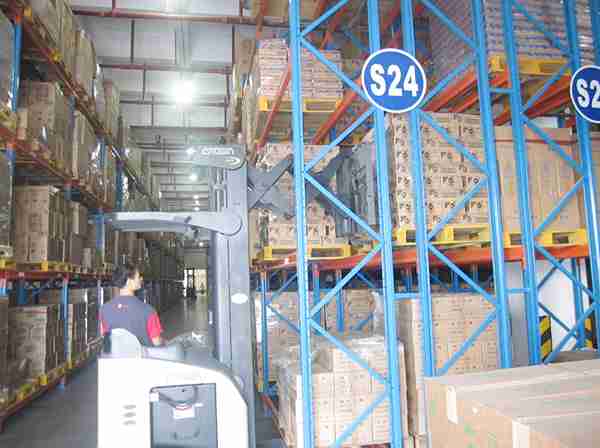📐 "First 50 Enterprise Queries Get Custom 3D Warehouse Design" Plan

Introduction
Cold storage facilities operate under extreme conditions where space optimization and energy efficiency are critical. Traditional storage systems often fail to maximize capacity, leading to wasted cubic footage and inflated refrigeration costs. Double deep racking for cold storage has emerged as the most effective solution, nearly doubling storage density while maintaining accessibility—a game-changer for frozen food, pharmaceuticals, and other temperature-sensitive industries.
This in-depth guide explores why double deep racking for cold storage outperforms conventional systems, how it reduces operational costs, and best practices for seamless integration. By the end, businesses will understand how to maximize cold storage efficiency with this innovative racking solution.

1. Why Cold Storage Demands Double Deep Racking
1.1 The High Cost of Wasted Space in Cold Warehouses
Every square foot in a cold storage facility consumes energy. Traditional single-deep racking wastes valuable space with excessive aisles, forcing businesses to either expand facilities or operate inefficiently. Double deep racking for cold storage eliminates this problem by storing pallets two-deep, reducing aisle space by up to 50% and slashing energy consumption.
1.2 How Double Deep Racking Reduces Refrigeration Costs
Fewer aisles mean less air circulation, directly lowering refrigeration demands. Studies show that facilities using double deep racking for cold storage reduce energy usage by 15-25%, translating to six-figure annual savings for large warehouses.
1.3 Ideal Industries for Double Deep Racking in Cold Storage
- Frozen food distribution (higher pallet volume, slower turnover)
- Pharmaceutical storage (batch tracking, FIFO compliance)
- Dairy and seafood logistics (high-density, temperature-sensitive goods)
2. Structural Advantages of Double Deep Racking for Cold Storage
2.1 Heavy-Duty Construction for Sub-Zero Environments
Unlike standard racking, double deep racking for cold storage uses galvanized steel to resist condensation and corrosion. This ensures durability in freezer warehouses where temperatures drop below -20°F (-29°C).
2.2 Optimized Load Distribution
- Deeper upright frames prevent deflection under heavy loads.
- Reinforced crossbeams support double-stacked pallets without sagging.
2.3 Customizable Configurations for Different Workflows
- FIFO (First-In-First-Out) – Ideal for perishable goods.
- LIFO (Last-In-First-Out) – Best for non-perishable bulk storage.
3. Comparing Double Deep Racking to Other Cold Storage Systems
3.1 Double Deep vs. Selective Racking
| Feature | Double Deep Racking | Selective Racking |
|---|---|---|
| Storage Density | 85% higher | Standard |
| Accessibility | Requires reach trucks | Direct access |
| Energy Efficiency | Best for cold storage | Moderate |
Verdict: Double deep racking for cold storage wins for businesses needing maximum space utilization.
3.2 Double Deep vs. Drive-In Racking
- Drive-in racking offers higher density but no selectivity (LIFO only).
- Double deep racking allows partial selectivity, making it better for mixed inventory.
3.3 Double Deep vs. Push-Back Racking
- Push-back racking is dynamic but costs 30% more.
- Double deep racking for cold storage provides similar density at a lower price.
4. Best Practices for Implementing Double Deep Racking in Cold Storage
4.1 Warehouse Layout Optimization
- Aisle Width: 10-12 feet (narrower than selective racking).
- Rack Height: Up to 40 feet (requires proper forklift selection).
4.2 Choosing the Right Forklifts
- Double-reach trucks are mandatory for accessing second-deep pallets.
- Articulating forklifts improve maneuverability in tight aisles.
4.3 Preventing Common Cold Storage Racking Issues
- Ice buildup – Regular de-icing prevents structural damage.
- Forklift collisions – Install impact guards on uprights.
5. Real-World Success: How Double Deep Racking Transformed a Frozen Food Warehouse
A leading frozen food distributor faced 30% wasted space with selective racking. After switching to double deep racking for cold storage, they achieved:
✅ 40% more pallet positions
✅ 18% lower energy costs
✅ ROI in under 24 months
6. Future Trends in Cold Storage Racking
- Automated Guided Vehicles (AGVs) for hands-free pallet retrieval.
- Smart sensors to monitor rack integrity in real time.
Conclusion
For businesses struggling with cold storage inefficiencies, double deep racking for cold storage is the ultimate solution. It maximizes space, cuts energy costs, and improves workflow efficiency—making it a must-have for modern cold chain logistics.
Need a custom solution? Consult a cold storage racking specialist today to optimize your warehouse.
FAQs
1. Can double deep racking handle FIFO inventory in cold storage?
Yes, with proper lane management, businesses can maintain FIFO compliance efficiently.
2. What’s the maximum weight capacity for double deep racking in freezers?
Most systems support up to 5,000 lbs per pallet position, but custom designs allow for heavier loads.
3. How does double deep racking impact order picking speed?
Slightly slower than selective racking but faster than drive-in systems. Proper training minimizes delays.
4. Is double deep racking compatible with automated storage systems?
Absolutely—AS/RS integration enhances efficiency in high-density cold storage.
5. What maintenance is required for double deep racking in sub-zero conditions?
- Monthly inspections for ice buildup and corrosion.
- Annual load testing to ensure structural integrity.




